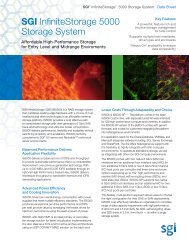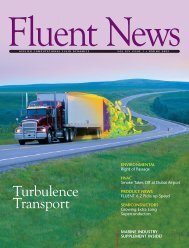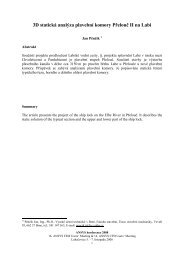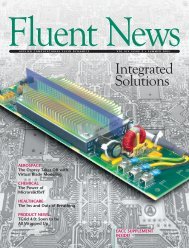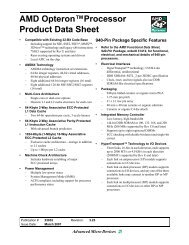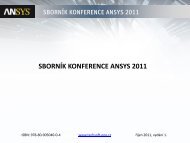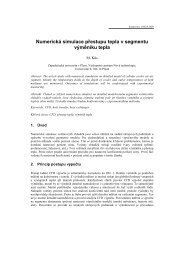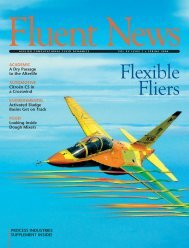Wind Turbine
Wind Turbine
Wind Turbine
You also want an ePaper? Increase the reach of your titles
YUMPU automatically turns print PDFs into web optimized ePapers that Google loves.
semiconductor<br />
Optimization of Vapor Purging<br />
in Wafer Isolation Pods<br />
by Keyvan Keyhani and Sameer Abu-Zaid, Asyst Technologies, Inc., Fremont, CA<br />
Asyst Technologies, Inc. is the<br />
world’s leading provider of<br />
environmental and automated<br />
work-in-progress material<br />
management systems for the semiconductor<br />
manufacturing industry.<br />
For the fabrication of integrated circuits,<br />
Asyst’s automated wafer isolation<br />
solutions enable the safe and<br />
rapid transfer of wafers between<br />
process equipment and the fabrication<br />
line, thus increasing production<br />
yield and reducing operating<br />
expenses. At Asyst, CFD analysis is<br />
used for design optimization during<br />
product development, performance<br />
verification of existing<br />
systems, and troubleshooting of contamination<br />
problems. CFD has<br />
proven to be a valuable tool in the<br />
design and analysis of a broad range<br />
of environmental isolation systems.<br />
As an example of the value of<br />
CFD analysis at Asyst, FLUENT has<br />
been used to optimize nitrogen purg-<br />
Geometry of the CFD model. The front surfaces of the FOUP<br />
have been removed to display the wafers. The inlet and<br />
outlet ports are shown on the bottom in blue and green,<br />
respectively.<br />
ing of a 300mm front opening unified<br />
pod (FOUP). Vapors inside FOUPs<br />
can damage wafers during transport,<br />
storage, and queuing between<br />
processes. For example, moisture<br />
can cause native oxide growth, corrosion,<br />
and cracking of films, and<br />
contamination by various organic<br />
compounds can degrade the electrical<br />
properties of integrated circuits.<br />
Purging with an inert gas, such<br />
as nitrogen, is a method of removing<br />
harmful vapors from FOUPs.<br />
To determine optimal purging<br />
methods, a CFD model of the system<br />
was developed. A FOUP<br />
geometry filled with 25 wafers was<br />
first constructed using Pro/E, and<br />
the model was imported into<br />
GAMBIT for meshing. The FOUP was<br />
initially set to contain air (with 20.7%<br />
oxygen). Pure nitrogen was then<br />
injected through inlet ports on the<br />
bottom of the FOUP, and the transient<br />
change in vapor concentration<br />
was computed. Various injection<br />
and exhaust methods were simulated<br />
using the same total amount<br />
of nitrogen for all cases, to determine<br />
the fastest rate of oxygen<br />
removal in all regions of the FOUP.<br />
Examination of a series of oxygen<br />
contour plots on the center<br />
plane of the FOUP show that the<br />
average concentration of oxygen<br />
drops rapidly over time, and that<br />
regions between the wafers can be<br />
effectively purged within an acceptable<br />
time period. Plots of oxygen<br />
concentration vs. time between two<br />
wafers show good agreement<br />
between FLUENT predictions and<br />
experiment. Using CFD as a predictive<br />
tool for purging optimization<br />
is less expensive than<br />
experimentation and provides<br />
Contours of mass percent of oxygen on a plane through the<br />
wafer centers after 40s of purging (not the optimal purge<br />
results). The FOUP initially has 20.7% oxygen (red) in every<br />
region.<br />
% oxygen<br />
100<br />
10<br />
1<br />
0.1<br />
0.01<br />
0 40 80<br />
FLUENT<br />
Measurement<br />
120 160 200 240<br />
time (s)<br />
Comparison of FLUENT results and data at the center point<br />
between the top two wafers (not the optimal purge results)<br />
detailed concentration results in every<br />
location within the FOUP.<br />
Work is ongoing at Asyst to further<br />
improve the purging of FOUPs<br />
using FLUENT simulations. Asyst is<br />
also presently using FLUENT for<br />
design optimization of the next generation<br />
of ultra-clean mini-environments<br />
for automated 300 mm<br />
wafer handling. ■<br />
materials processing<br />
Fluent NEWS spring 2002<br />
S7



